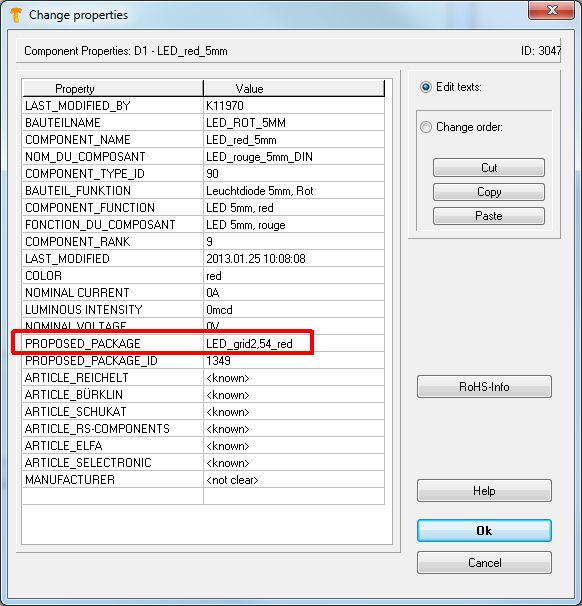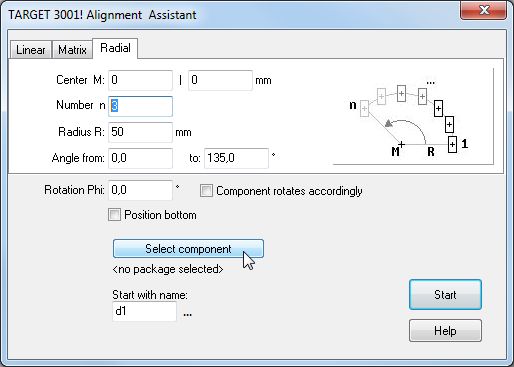Alignment Assistant
In "Menu Actions"...
General
The alignment assistant helps placing components according to special geometrical figures (e.g. 20 LEDs along half a circle). TARGET 3001! provides the basic figures: "line", "matrix", "circle". The alignment assistant can be used in schematic as well as in the layout view where it is supposed to be used mostly. The opening dialog looks like this:
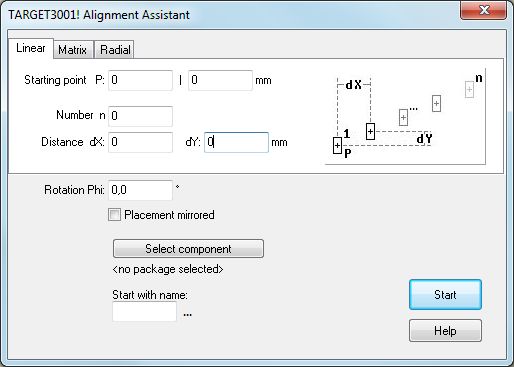
Linear alignment
The logic of this linear placement tool (creating a horizontal, vertical or diagonal row of a certain number of the same component types) follows this picture:

The starting point P represents the placement of the handle cross of the first component of the row. dX means the vertical distance to the handle cross of the next component. dY means the horizontal distance to the next component. n means the number of components to be placed in this row.
Enter the coordinates of the desired starting point P as x- and y- coordinates to the first field of the dialog. You can copy the coordinates of the desired starting point from the canvas of your layout to this form by pressing key [Home] after you had hovered the cursor to the desired starting position. Open the assistant again and find the coordinates in the first field. We stayed with the absolute zero in our example. After you have defined the row as shown in the following picture:
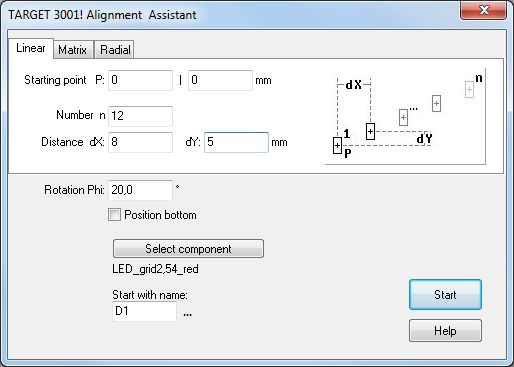
Please note that we have changed to the layout view and set the path to an appropriate LED-package. You will generate the following result:
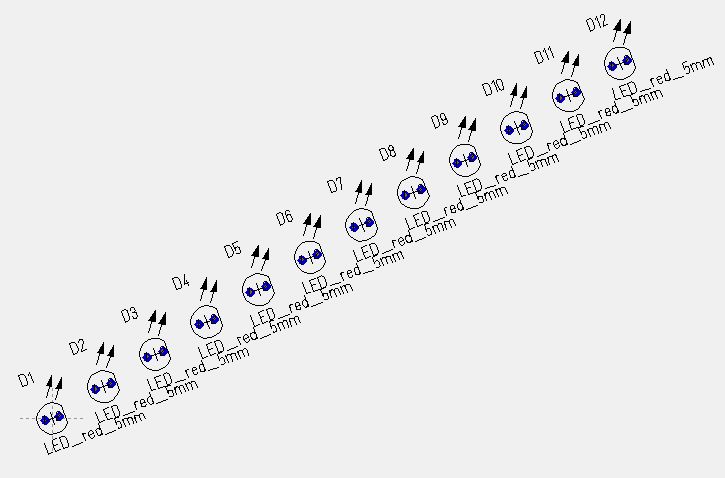
We had predefined a rotation of 20° in a mathematical positive sense. This might make them easier to connect.
The desired direction of your row please define by using appropriate signs (+ or -) at dX and dY. In the above mentioned example the direction of the row is "northeast" because we are moving in an X and Y positive sense. The numbering begins with component number 100, as entered to the dialog (you can enter individual numbers). The component numbering plays an important role regarding the connection of rowed components (connection of symbols in the schematic and the packages in the layout). When moving from a rowed number of symbols in the schematic to a (maybe differently) rowed number of packages in the layout you must ignore the package proposals but assign a matching amount of packages having identical component names.
Matrix alignment
Maybe you want to assemble components in matrix form (rows and columns). Please choose the section "Matrix" from the dialog.
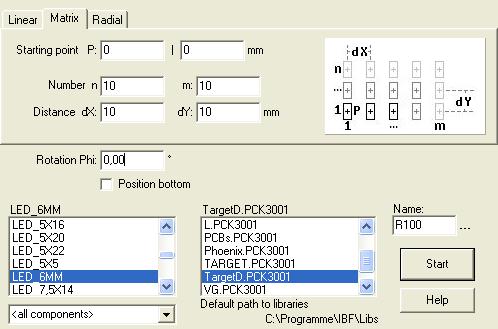
The starting point P means the coordinates of the handle cross. The number of horizontal rows is defined by "n", the number of vertical columns is defined by m". You must define each in the dialog. The distance between the rows in mm or inch please define by dY, the distance between the columns please define by dX.

Also in this mode you can define a certain degree of rotation "Phi" of all elements of the matrix (rotation in mathematic positive sense) for example 20°. You might also define a mirrored display to assemble upon top or bottom layer.
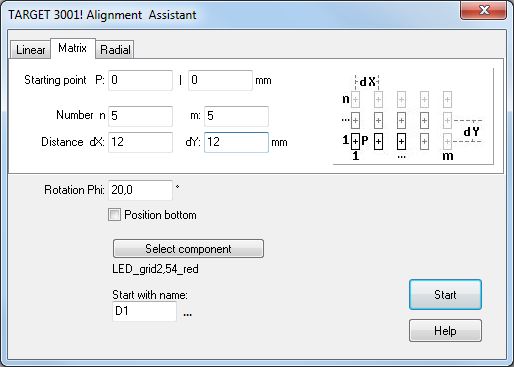
You would reach this:
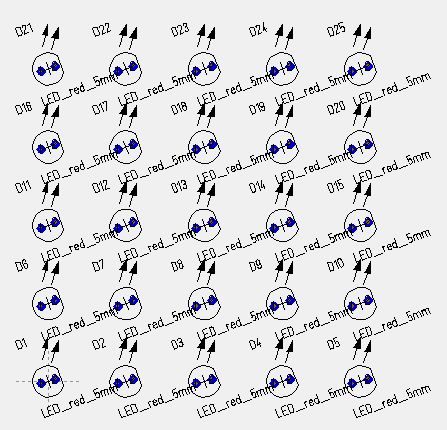
Please note that you can take the coordinates of the Start-LED from the cursor position on the schematic (Press key [Pos1]and open placement assistant).
Radial alignment
For radial assembly of components please choose section "Radial". Prior to this you might have caught the cursor coordinates of the coming center of the circle by pressing [Home] at cursor position. Please enter the number of components to the dialog. The radius R means the distance between center M and the handle cross of a component in mm or inch.

Now you should decide at which degree the circle shall start, which carries your components and how far the angle opens. these options describe the shape of your arc. Enter these values to the fields "Angle from" and "to" ein. This mode of automatic placement allows a gradual Rotation Phi of any component like in the other modes relative to its own vertical axis. The following settings

will have this result:
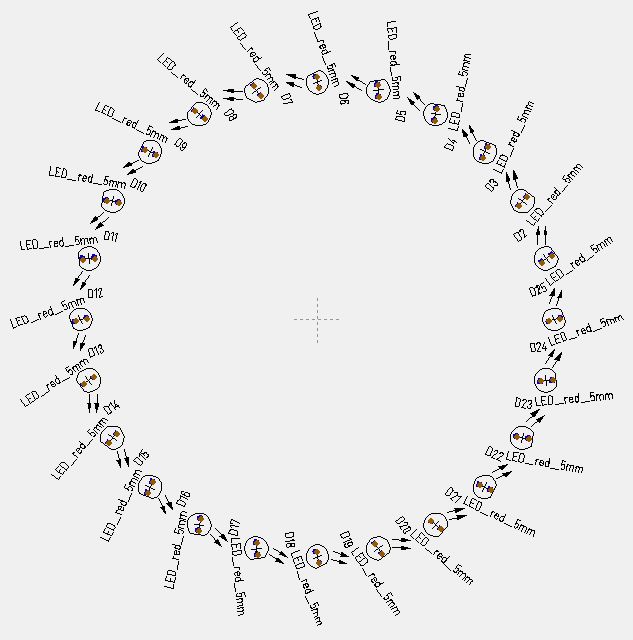
The tick in the field: "Component rotates accordingly" effects, that the rotation of the component is defined by the same angle relative to the radius. The following example makes this clear:

Schematic symbols and the alignment of their package proposals in the layout
You have placed a certain number of identical symbols with identical package proposals in the schematic. Now you wish to align the packages in a special geometric form in the layout. You need the information:
What's the name of the package proposed?
Guess we would have placed 3 LEDs, 5mm, red, named D1, D2 und D3 in the schematic. Doubleclick on one of the handles in order to open the "Change Symbols"- dialog. Click button Properties bottom right of the dialog. The dialog Change properties pops up and gives information on the name of the package proposed.
The name of the package is LED_grid2,54_red.
Now change to the layout view, complete the board outline and cancel the Placement-Assistant. Open menu Actions and Launch the Alignment-Assistant.
Select mode of alignment for example Radial (see tab) and define the Number n of the packages you wish to align in this case 3. Select Radius and angle and then choose package LED_grid2,54_red using button "Select component". Point at the package from which the alignment shall start, in our case d1.
Three packages named "LED_grid,54_red" now get aligned according to the settings of the dialog starting with d1 and being a sequence (a row of objects). You can define the number of objects as well as the name of the first object. The following components are subsequent d2 and d3. Thus you may define how many objects the sequence has (number n) and from which one it starts (name).
If you had 20 red LEDs placed in your schematic you might align e.g. n=7 7 objects starting with d4 using the Alignment Assistant (d4,d5,d6,d7,d8,d9,d10). But not e.g. d3, d6, d10, d11 and d18.


